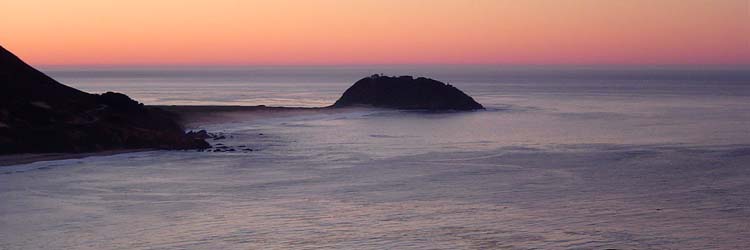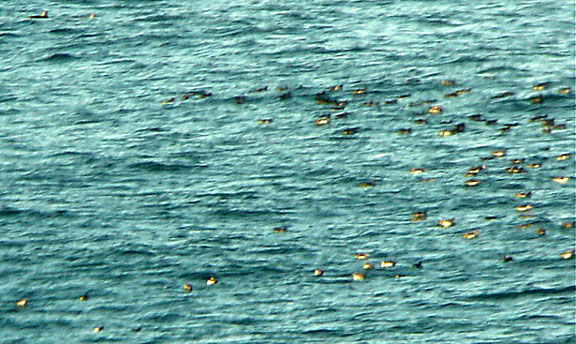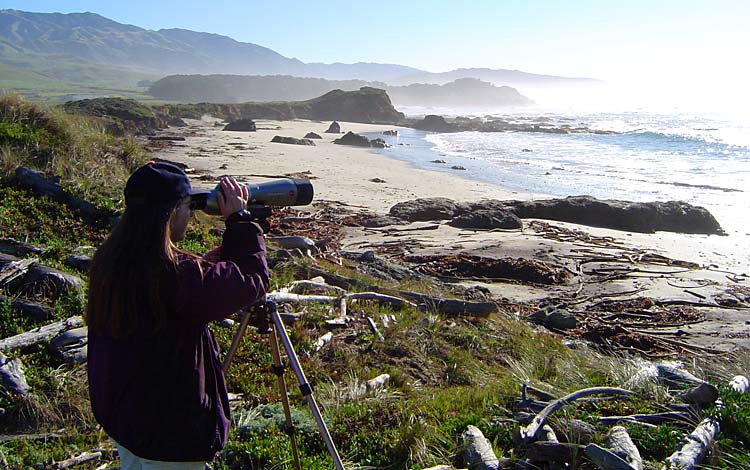

It was an exceptionally beautiful day at Pt. Sur this morning. Clear,
spectacular sunrise, no wind: we've never had better conditions. I assumed
that the flat calm seas would mean “no birds offshore” — but this proved
very wrong. The seas were alive with thousands of birds, and there were
several ‘hot-spots’ attracting hundreds of gulls, pelicans, cormorants,
and seabirds to apparent rich runs of small fish. I very quickly noted
that a huge movement of Black-vented Shearwaters was underway. They were
just streaming north. I took the 15 minute span from 0745-0800 to use a
hand-clicker on just them: 820 in 15 minutes. They continued in good numbers
for the full 2.5 hours we had at Pt. Sur before having to leave at 9:30
when the State Park tour group enters the gate at Hwy 1. After counting
the 820/15 mins., I found that there were two major foraging flocks just
right off the point — and I mean just a hundred yards off the point. Hundreds
of Black-vents were in those flocks — perhaps 1500 between the two flocks
— along with hundreds of Rhinoceros Auklets — perhaps 1500 of them — plus
countless gulls, hundreds of pelicans, dozens of cormorants and murres.
I decided the most conservative figure for Black-vented Shearwater was
to take the 15 minute count, assume the same rate for an hour, and use
that figure: ~3300 Black-vented Shearwaters passing Pt. Sur this morning.
The rate of passage decreased during the morning but there was the 1500
on the water just off the Point.
 digiscoped view of seabird flock 19 Dec
2004, mostly Black-vented Shearwaters but Pacific Loon (upper left) and
Rhinoceros Auklets (lower left)
Pt. Sur Lighthouse
with Don scoping seabird flocks photo by Rita Carratello |
||
|
XANTUS’S MURRELET (2 together): This was earlier in the morning and much closer. The near edges of the foraging flock was right below the Pt. Sur Lighthouse. Most of the close birds were Rhinoceros Auklets, with a few larger loons and Common Murres and gulls and cormorants. Right at the nearest edge of the group were a pair of tiny alcids — black above and white below — that were actively diving so they were mostly underwater. When they'd come up briefly, I'd focus on one of them and, in fact, never scrutinized the second bird although my impression was that it was identical. The one I scoped intently had a very short and thin black bill, a dark cap that came down below the eye, but the entire throat and chin was white. The blackish upperparts had a slightly gray cast. The tail was very short and white undertail coverts were obvious during the dive. The underparts were clean white, no shoulder extensions. I could even see a tiny white half-eyelid above the eye [eye otherwise in dark of face]. After a couple dives I lost them as I got distracted with other things. They were obviously Xantus's Murrelets, either a pair or an adult and a full-grown youngster, by their tiny size — looking half the size of the Rhino Auklets — and the very short thin bills. |
||
|
Also in our Pt. Sur territory:
|
||
| SNOW GOOSE: an adult at a vernal pool below Pt. Sur — a large,
heavy all-white goose with black primaries and a long, heavy bill with
a very prominent 'grinning' patch on the pink bill.
FERRUGINOUS HAWK: an adult (e.g., much rufous to thighs) was watched both in flight and perched on a telephone pole. A large pale-headed Buteo with much rufous to upperwings, a pale and mostly whitish tail washed a bit with rusty on the dingy subterminal band, and large whitish patches at base of primaries when the upperwings were viewed in flight. Underparts very white except for rusty things and few flank spots; bill and eye yellow. |
||
| BARROW'S GOLDENEYE: a female with 3 female plumaged Common Goldeneyes in the Little Sur River lagoon. Identified by all-yellowish bill while the Common Goldeneyes had either all black bills (imms) or black bill with yellow tip (adult female). The Barrow's not only had an all-yellow bill, including basal portions, but looked short billed, had a very steep forehead, looked slightly darker rusty-brown on the head (which contrasted slightly more with white on foreneck), and looked to have less white in the wing than the Commons, showing just two patches of small white, rather than the three patches shown by the swimming adult female Common. All the goldeneyes were actively diving. This bird was scoped at 60X from a good distance but Rita was able to come view it and confirm the bill color. | ||
|
All in all, an exceptional day for the "Pt. Sur Lighthouse" team. Alas, as always, the light conditions become progressively worse as the day passes and the sun moves to the west. But 'oh, what a beautiful morning, oh what a beautiful day'.....  view looking south from Pt. Sur towards
the Big Sur R. mouth, now in the glare
|